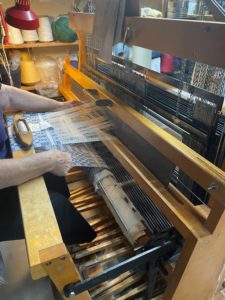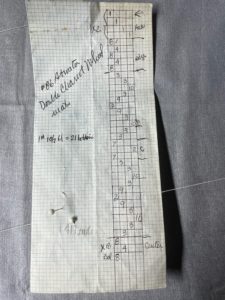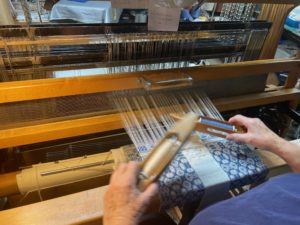Overshot is a traditional American weave that evolved mostly in New England. It uses 2 (or more) different types of weft yarns (the horizontal yarns) and floats create a pattern. Floats are simply weft yarns that float over top of the warp yarns to create a pattern on one side of the fabric. The Double Chariot Wheel overshot pattern can be documented back to the first half of the 1800s. Overshot is typically woven on 4 harnesses.
First, don’t let “just 4 harnesses” or the age of the Double Chariot Wheel pattern lull you into thinking overshot is simple or boring. The family of overshot patterns is enormous and the variations are practically infinite. Their names range from Double Chariot Wheel to Blooming Leaf of Mexico and Maltese Cross and all are created with just 4 harnesses. Overshot was a way for 19th century weavers to express their creativity in a beautiful way while still producing durable and functional items.

So how does the weaver actually do this? Overshot is woven on 4 harnesses. In the video, the harnesses are what lift the white warp threads so that the weaver can throw the shuttle through with the weft yarns. Each harness is threaded with different warp threads. Looms are fun machines because then you can lift different combinations of harnesses to get different patterns. The more harnesses you have available, the more combinations you can create and the more complex your weave will be.
Now, let’s lift the harnesses! If you look in the photo above, at the bottom of the loom you’ll see long sticks, they’re called treadles and they’re essentially pedals the weaver pushes down with her feet to make the harnesses go up and down. These treadles can be hooked to one or more harnesses and each harness may have more than one treadle that lifts it in combination with other harnesses depending on the weave’s pattern.
 Each weave pattern has a specific treadle pattern that the weaver performs. Here you’ll see one of Rachael’s treadle charts for Double Chariot Wheel, complete with notes that I still can’t read 100% of despite my 40-something years of exposure to her handwriting. There are, however, repeats noted as well as edges and the center part of the pattern. Once she reaches the bottom of the treadle chart, she works her way back up to finish the other end of the piece. The number of repeats of each section determines the length of the piece, whether it’s short like a placement or longer like a table runner. Also noted here is “417 ends”: which is to say 417 of the white warp threads are on the loom, threaded through specific harnesses, to produce this pattern. Trust me, this is not a big number compared to some of Rachael’s other work.
Each weave pattern has a specific treadle pattern that the weaver performs. Here you’ll see one of Rachael’s treadle charts for Double Chariot Wheel, complete with notes that I still can’t read 100% of despite my 40-something years of exposure to her handwriting. There are, however, repeats noted as well as edges and the center part of the pattern. Once she reaches the bottom of the treadle chart, she works her way back up to finish the other end of the piece. The number of repeats of each section determines the length of the piece, whether it’s short like a placement or longer like a table runner. Also noted here is “417 ends”: which is to say 417 of the white warp threads are on the loom, threaded through specific harnesses, to produce this pattern. Trust me, this is not a big number compared to some of Rachael’s other work.
 One of my favorite things about overshot is that it’s reversible. We’ve tried to catch both sides of each overshot piece in the photos for the shop for this reason. You can flip a runner or placemat when it gets a little dirty and use the other side and no one will know! You can also alternate the contrasting sides of the placemats when you set your holiday table for a beautiful effect. It’s also a good way to distinguish my placemat from my daughter’s at the table. And sometimes? I just like the lighter side better than the darker side…
One of my favorite things about overshot is that it’s reversible. We’ve tried to catch both sides of each overshot piece in the photos for the shop for this reason. You can flip a runner or placemat when it gets a little dirty and use the other side and no one will know! You can also alternate the contrasting sides of the placemats when you set your holiday table for a beautiful effect. It’s also a good way to distinguish my placemat from my daughter’s at the table. And sometimes? I just like the lighter side better than the darker side…
On Etsy we have both Double Chariot Wheel placemats and Double Chariot wheel runners available (at least at the time of this post!).
